page 1
~ The Study of Threes ~
http://threesology.org
Whereas many people consider that the cyclical event of the human female Menstrual cycle can be correlated with the Moon's rotation, and that other geophysical events seem to be reflected in the behavior of various plant and animal species; is it possible that the Solstice/Equinox events have played some measurable influence on the predisposition of biological life forms to exhibit some numerically quantifiable relationship? For the present discussion, by looking at the images to the right, it is clear that the so-called interrelated 4 separate events of 2 Solstices and 2 Equinoxes are customarily viewed as a pattern-of-three. On June 21 or 22, (the Summer Solstice), the Earth is positioned in its orbit so that the North Pole is leaning 23.5° toward the sun. (The word solstice is Latin in origin and is roughly translated as: "the sun stood still.") On March 21st and September 23rd, (the Spring and Autumn Equinoxes), two days when the northern and southern hemispheres receive the same amount of sunlight (at the Equator, the Sun is directly overhead) and the days and nights are of the same length. The 23.5° tilt of the Earth’s axis is not towards the Sun, but lies at a right angle to an imaginary Earth -Sun line... (Equinox means "equal night.") On December 21 or 22, (the Winter Solstice), the Earth is positioned so that the South Pole is leaning 23.5° toward the sun. |
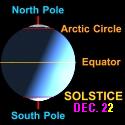 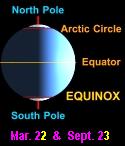 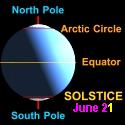 Equinox and Solstice Guide |
| Latitude | Summer Solstice June 21/22 |
Spring Equinox March 21/22 Autumn Equinox September 22/23 |
Winter Solstice December 21/22 |
| 90° N | 23.5° | 0° | - 23.5° |
| 70° N | 43.5° | 20° | -3.5° |
| 66.5° N | 47° | 23.5° | 0° |
| 60° N | 53.5° | 30° | 6.5° |
| 50° N | 63.5° | 40° | 16.5° |
| 23.5° N | 90° | 66.5° | 43° |
| 0° | 66.5° | 90° | 66.5° |
| 23.5° S | 43° | 66.5° | 90° |
| 50° S | 16.5° | 40° | 63.5° |
| 60° S | 6.5° | 30° | 53.5° |
| 66.5° S | 0° | 23.5° | 47° |
| 70° S | -3.5° | 20° | 43.5° |
| 90° S | - 23.5° | 0° | 23.5° |
Note: Different references might provide different dates given for the Vernal (Spring) Equinox and Summer Solstice. The three dates of March 20/21-22 may be given for the Vernal Equinox and June 20/21-22 may be given for the Summer Solstice. Most references to these events do not include any reference to day 20 in either case, but such a date can be arrived at by using equations where the type of calendar and time zones are taken into consideration.)
Earth's axis of rotation is tilted with respect to its orbital plane ("plane of the ecliptic") by 23.5° from vertical to the orbital plane. The tilt of Earth's axis accounts for why there are seasonal changes in (a) the hours of daylight and (b) the intensity of solar radiation at any location on Earth. The following table is a guide to seasonal changes in the "position" of the Sun (when and where is directly overhead at noon) and in hours of sunlight.
| Date | Sun overhead at | Event | Sunlight |
| Sept. 23rd | Equator | Autumnal Equinox | 12 hrs of sunlight everywhere |
| Dec. 23rd | 23.5° S (Capricorn) | Winter Solstice | Perpetual sunlight @ > 66.5° (Antarctic
Circle) —South Pole— |
| Mar. 23rd | Equator | Vernal Equinox | 12 hrs of sunlight everywhere |
| June 23rd | 23.5° N (Cancer) | Summer Solstice | Perpetual sunlight @ > 66.5° (Arctic
Circle) —North Pole— |
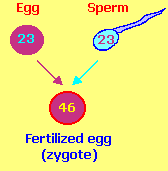
By combining the 23.5° (tilt of the Earth's axis) value during the Winter solstice with the similarly distinctive 23.5° (tilt of the Earth's axis) value during the Summer Solstice, we come up with a value of 47. In considering what biological event(s) may have been influenced by this geophysical phenomena, it is interesting to note that during development of a human baby, there are 23 chromosomes from the male and 23 chromosomes from the female for a total of 46. The human body typically has 46 chromosomes and a child born with 47 chromosomes is often described as having the condition of a trisomic deformity such as one of the three types of Down Syndrome. While the one extra-chromosome occurrence frequently is identified with deformities, there are other deformities caused by having one (or more) fewer chromosomes, as well as other types of deformities involving deletions, mixtures, etc...

When we make our egg or sperm there is an important process of dividing the 46 chromosomes in half, so that the egg contains 22 autosomes and one X chromosome and the sperm contains 22 autosomes and one "sex-determining" chromosome. The sex chromosome in the sperm determines the sex of the baby. If the sperm is carrying an X chromosome the baby will be female. If the sperm is carrying a Y chromosome the baby will be a male. When the 23 chromosomes in the egg fuse with the 23 chromosomes in the sperm the total number in the baby is restored to 46 chromosomes.
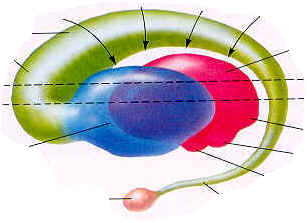
As an aside note to a correlation not typically made, if we compare the above egg/sperm image with the structure of the primitive (reptilian) human brain, the correlation seems rather striking. Such a correlation and acknowledgement of similarity not only in form but also on the level that both represent fundamental characteristics of later development, influences one to wonder whether or not there is something to the notion of a microscopic/macroscopic mirror-imaging effect taking place in many instances and is sometimes expressed as a microcosmic/macrocosmic interrelationship.
3 types of chromosomes based on the position of the centromere:
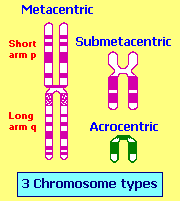 [1] Metacentric chromosomes have their centromere near
the center of the chromosome.
[1] Metacentric chromosomes have their centromere near
the center of the chromosome.[2] Submetacentric chromosomes have slightly off-center centromeres, such that one chromosome arm is longer than the other.
[3] Acrocentric chromosomes have the centromere located very near to one end.
Meiosis is the cell division process that produces cells that will become the egg and sperm cells of an organism. Cells produced by meiosis have half the normal number of chromosomes (each meiotic cell has one copy of each chromosome), so that when an egg and sperm fuse at fertilization, the resulting zygote has the two copies of each chromosome it needs for proper development. Sometimes during the course of normal meiosis, chromosomes are not correctly distributed from a dividing cell into the two daughter cells. When this happens, one daughter cell has twice the number of copies of that particular chromosome and the other daughter is left with no copies of that chromosome. If such a cell is later used in a fertilization event, the resulting zygote will have either a total of ONE of that type of chromosome (monosomy) or have THREE of that type of chromosome (trisomy). Abnormal numbers of chromosomes are very often incompatible with life. In general, the human body can tolerate excess genetic material more easily than it can tolerate missing genetic material.
Some readers may consider it a wild stretch of the imagination to make a correlation with the 47 value found in the events of the Solstices and the 47 value found in extra-chromosome genetic mutations, because their own review of literature on chromosomal aberrations indicates that there are variations as to the number (and quality) of chromosomes which cause genetic abnormalities. But even those who have not read anything on chromosomal abnormalities may be skeptical and question that such a numerical inference appears to be an arbitrarily designed pattern-match akin more to a rationalized scheme of numerology than to any actual portrayal of comparative significance. Such people in this particular instance may disagree when there is variation to an identified pattern, even though they accept the variations of physiological differences occurring with other geo-physical comparisons.
For example:
- They accept the correlation made between the lunar cycle and female menstruation even though there are variations to the cyclical patterns of female menstruation.
- They accept the geophysical event of the Solar cycle can have additional micro-events associated with the overall macro effects of irradiation resulting in independently cyclical events such as solar flares.
- They accept the correlation between dates on a human-made calendar and seasonal changes that are frequently variable with respect to expectations of rain, snow, heat, etc...
For some, they can not easily grasp the purpose for suggesting such a correlation between a geophysical event and any phenomena of biological activity, much less the one being offered on this page. For the correlation being outlined here, if such a circumstance can be found to have some basis in truth, then it may be possible to identify potential future changes that will occur on a genetic level. Not that we would necessarily want to prevent the occurrence, but perhaps we might want to accelerate, modify, and enhance the processes of nature to suit some specific purpose.
An example of this idea is reflected in our correlation between solar irradiation and cellular changes which produce sunburn, suntan, and various cancers. Increased knowledge of such a correlation is indeed of great service to all of us in terms of improving the conditions of our life. And while some argue that the idea about the Sun's rays is a fact and not merely an assumption based on what may appear to be superficial correspondences, this was not always the case. For even this presently taken-for-granted idea was at one time someone's mere conjecture.
A long time ago, no doubt some early hominids thought of the Sun as a god, or some attribute of a god. In other words, all ideas must have some initial beginning that may or may not be modified as new understanding becomes available.
Another Geophysical-related event that may have influenced biological behavior is that of the change in the Earth's polar axes:
There is no doubt that the Planet Earth's Polar Axis has shifted during its geological history. Evidence of such shifting can be found all over the world. Any academic difference of opinion resides in the question of exactly when these Polar Axis Shifts occurred:
- On the one hand, there are traditional scientists and geologists who date these shifts millions of years into the past, stating that there is absolutely no evidence that such shifts occurred within recent geologic times.
- But on the other hand, there is the Velikovskian School which dictates that at least one of these Polar Axis Shifts, perhaps even two or three of them, occurred within recorded historic times.
This academic disagreement was partly reflected in what has become known as "The Velikovsky Affair", in which mainly Ivy League professors such as the late astronomer Carl Sagan of Cornell University and the (late) controversial paleontologist Stephen Jay Gould of Harvard University disputed the science of the theories of the late Dr. Immanuel Velikovsky of Princeton University.
The first type of chromosomal abnormality that causes Down Syndrome happens when either the sperm or the egg divides wrongly. All the chromosomes except one divide correctly. In Down Syndrome, that one is the 21st chromosome. The entire 21st pair goes over to one side. After conception, there are then three total copies of the 21st chromosome, instead of the two in normal persons. As the child develops, the extra chromosome is replicated in every cell of the body. The medical term for this is Trisomy 21, or non-disjunction. It accounts for about 95% of the causes of Down Syndrome.
In the second type of chromosomal abnormality that causes Down Syndrome an extra part of chromosome 21 is attached or stuck onto another chromosome. There are still only 46 chromosomes, but the extra part of number 21 is producing extra genetic products, resulting in Down Syndrome.
This form is usually inherited from a parent. Sometimes a person has only one normal 21st chromosome besides the translocated one. Such a person does not have Down Syndrome. However, if one of their children has two normal 21st chromosomes, besides the extra, that extra chromosome part is producing extra genetic products, and results in Down Syndrome. This type is called translocation trisomy 21. It accounts for about 3-4% of the causes of Down Syndrome.
In the third type of chromosomal abnormality, some of the cells have a trisomy, with 47 total chromosomes, and other cells will have the normal 46 chromosomes. There have been proposed two ways that this might happen.
One of the ways is that when the child was conceived, the very first cell division went wrong, the same as in standard trisomy 21. However, a little farther down the line, there was yet another error, resulting in the normal 46 chromosomes for that line of cells. If the second error occurred when there were only 2 cells, 1/2 of the chromosomes would have 46 chromosomes, and one half would have 47. If the error occurred when there were 4 cells, 1/4 of the cells would have 46 chromosomes, and 3/4 would have 47.
Another of the ways suggested is that the first cell division is normal. However, non disjunction of the 21st chromosome occurred later on. If it occurred when there were only 2 cells, 1/2 of the cells would have 47 chromosomes. If it occurred when there were 4 cells, 1/4 of the cells would have the trisomy. This type, no matter how it happened, is called mosaic trisomy 21. It accounts for about 1-2% of the causes of Down Syndrome.
Since only part of the cells have a trisomy, there is not as much of the extra genetic products being produced. Therefore, depending on the percentage of trisomic cells, this child might not have as many problems as someone with standard Trisomy 21, who has all trisomic cells.
Several forms of diabetes are associated with monogenetic defects in beta-cell function. These forms of diabetes are frequently characterized by onset of hyperglycemia at an early age (generally before age 25 years). They are referred to as maturity-onset diabetes of the young (MODY) and are characterized by impaired insulin secretion with minimal or no defects in insulin action. They are inherited in an autosomal dominant pattern. Abnormalities at three genetic loci on different chromosomes have been identified to date. |
Chromosomal abnormalities in the baby may be inherited from the parent or may occur with no family history. The following chromosomal problems are most common:
Three types of single gene disorders:
Examples include the following:
Notice the 3 different chromosome quantities outlined in the above descriptions: (divided by 2) Compare these numbers to the length of a day in hours, with respect to the development of life on Earth with its incrementally slowing rotation rate discussed on the "Earth's Rotation Rate" pages at this site. |
Page initially created: Sunday, July 1st, 2012, 5:57 AM
Page updated: Sunday, August, 19th, 2018... 9:03 AM
Herb O. Buckland
herbobuckland@hotmail.com
